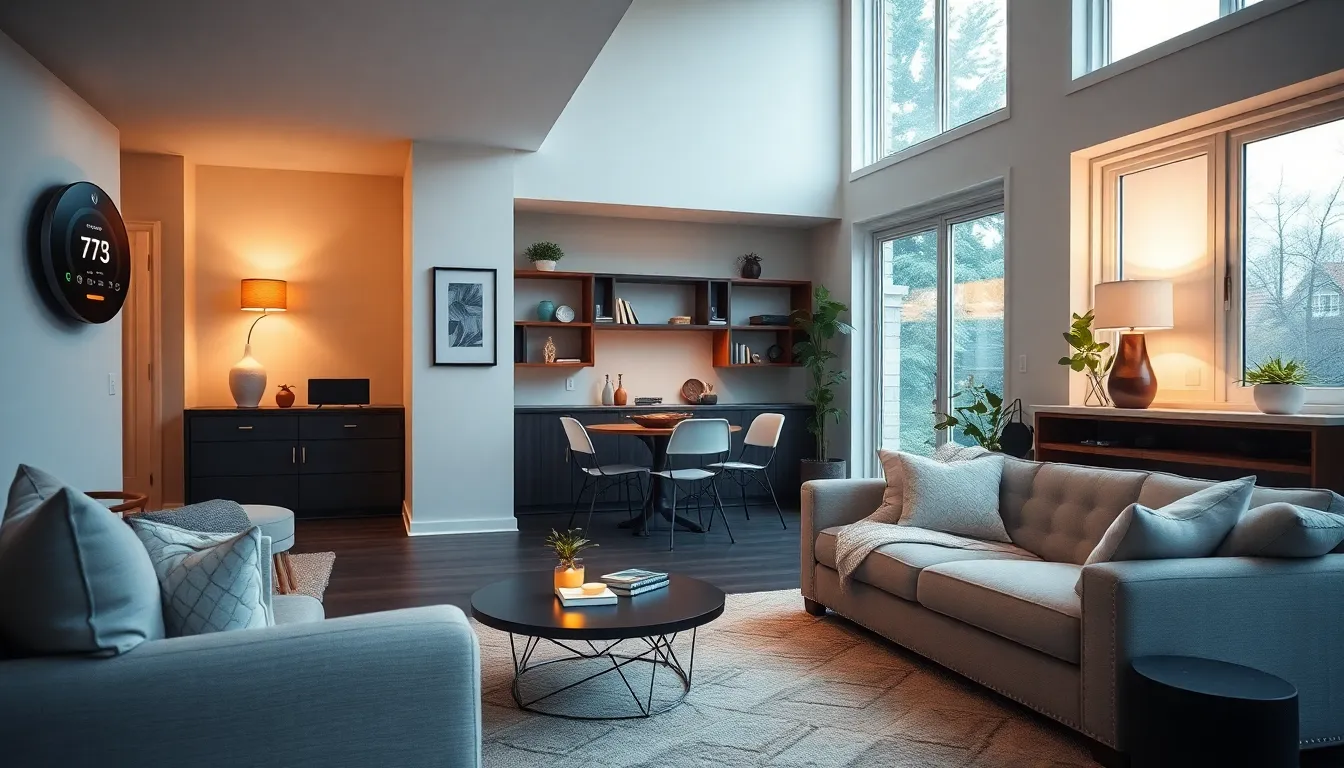Imagine walking into your home and having the lights turn on, the thermostat adjust, and your favorite playlist start playing—all without lifting a finger. Sounds like magic, right? Welcome to the world of home automation systems, where technology turns your home into a smart haven.
Table of Contents
ToggleOverview of Home Automation Systems
Home automation systems transform conventional living spaces into smart homes. They integrate various technologies to create a connected environment. Lighting systems, for example, can adjust automatically based on occupancy or time of day. Smart thermostats learn user preferences to optimize energy usage. Home security devices enhance safety, monitoring activity and sending alerts when necessary.
Versatility defines home automation systems. They support a range of devices, from smart speakers to climate control units. Voice-activated assistants streamline control over these devices. Users can command their devices hands-free, making interactions intuitive. Multi-device compatibility allows seamless integration, enhancing overall functionality.
Data-driven insights enhance user experience. Home automation systems collect data to provide personalized settings. Users benefit from remote access, adjusting settings via smartphones while away. This flexibility increases convenience and peace of mind.
Cost-effectiveness factors into home automation systems. Investing in smart devices reduces energy costs over time. Many systems also increase property value, appealing to potential buyers. Various financing options and rebates exist, making adoption more accessible.
Ultimately, home automation systems improve daily life quality, combining technology with comfort and convenience. Their range of features and capabilities continue to evolve, addressing modern lifestyle needs efficiently. Transitioning to a smart home presents simple opportunities and long-term benefits for those seeking innovation in their living environment.
Benefits of Home Automation

Home automation systems offer several advantages that enhance everyday life. These systems simplify tasks, increase security, and improve energy efficiency.
Increased Convenience
Convenience stands out as a primary benefit of home automation. Smart devices allow users to control lighting, temperature, and entertainment systems remotely. Voice commands and smartphone apps enable quick access to various functions, eliminating the need for manual adjustments. For example, automated routines can schedule lights to turn on at sunset or adjust the thermostat before arriving home. Such features save time and add comfort, making daily living more enjoyable. Overall, the ease of managing home environments contributes significantly to user satisfaction.
Enhanced Security
Home automation enhances security through integrated monitoring and alerting systems. Real-time notifications inform homeowners of unusual activities, providing peace of mind. Smart locks offer secure entry options, allowing remote locking and unlocking for trusted visitors. Cameras with motion detection capabilities provide instant video feeds to mobile devices. Additionally, automated lighting can simulate occupancy when no one is home, deterring potential intruders. This combination of features creates a comprehensive security solution tailored to modern needs.
Energy Efficiency
Energy efficiency ranks high among the benefits of home automation systems. Smart thermostats adjust heating and cooling based on occupancy and weather conditions, optimizing energy usage. Such adaptations can reduce utility bills significantly. Lighting controls automatically shut off lights in unoccupied rooms, further conserving energy. In fact, studies show that energy-efficient upgrades can lower overall consumption by 20-30%. With these advancements, homeowners not only save money but also contribute to environmental sustainability.
Types of Home Automation Systems
Home automation systems encompass various types, each offering unique features and benefits. Below are key categories that illustrate how technology integrates into daily living.
Smart Lighting Solutions
Smart lighting solutions provide flexibility and efficiency in managing home illumination. These systems allow users to adjust brightness levels and colors remotely or automatically based on time or occupancy. Many smart bulbs are compatible with voice assistants, offering hands-free control. Integration with motion sensors enhances convenience by turning lights on and off as needed. Users can also program lighting schedules to suit their routines, improving energy efficiency. Ultimately, smart lighting adds ambiance and functionality to living spaces.
Climate Control Technologies
Climate control technologies optimize home temperature and air quality. Smart thermostats learn household patterns and adjust settings accordingly, leading to energy savings. Control occurs remotely via smartphones, enabling adjustments when away from home. Some systems include smart vents that balance airflow throughout rooms for consistent comfort. Integration with weather forecasts ensures indoor conditions remain pleasant despite external changes. Overall, these technologies enhance comfort while promoting energy efficiency.
Home Security Systems
Home security systems play a vital role in protecting residences. These systems typically include cameras, motion sensors, and alarms. Users can monitor their properties in real-time through smartphone apps. Many devices send alerts for unusual activity, allowing for prompt response. Integration with lighting systems can create the illusion of occupancy to deter intruders. Additionally, features like video doorbells enhance security by allowing homeowners to see and communicate with visitors remotely. Overall, these systems provide reassurance and peace of mind.
Key Components of a Home Automation System
Home automation systems consist of several critical components that create a seamless experience. These elements work together to enhance convenience, security, and energy efficiency within smart homes.
Hub and Controller
The hub serves as the central control point for the entire home automation system. It connects various smart devices and facilitates communication between them. Users can manage devices through this hub, whether via smartphone applications or voice commands. Controllers typically offer user-friendly interfaces, enabling even those unfamiliar with technology to navigate easily. Data integration from the hub provides insights into energy usage and security alerts. Popular examples of hubs include SmartThings and Wink, which support a wide range of devices and platforms.
Smart Devices and Sensors
Smart devices and sensors form the backbone of home automation systems. These devices include smart bulbs, thermostats, cameras, and motion detectors, each designed for specific functionalities. Smart bulbs, for example, allow users to adjust brightness and color remotely, enhancing ambiance. Thermostats monitor and learn user preferences to optimize heating and cooling schedules. Sensors detect motion or environmental changes, triggering alerts and automating responses. Together, these devices promote energy efficiency and enhance security, providing peace of mind and effortless control over home environments. Wired and wireless options are available to fit diverse installation needs.
Considerations When Choosing a Home Automation System
Selecting the right home automation system involves several key factors to ensure a seamless experience.
Compatibility with Existing Devices
Compatibility plays a crucial role in the effectiveness of a home automation system. Users should evaluate if the system integrates well with existing devices, such as smart speakers, lights, and thermostats. Many systems are designed to work with a variety of brands and protocols, which simplifies the connection process. Assessing supported platforms ensures smooth operation. Testing compatibility before making a purchase helps avoid future issues and enhances overall functionality. Consumers can benefit from reviewing compatibility guides provided by manufacturers.
Scalability of the System
Scalability limits must also be considered when choosing a home automation system. Users desire the flexibility to expand their system as needs change over time. Systems that allow for easy addition of devices offer better long-term value. Selecting a platform with modular capabilities ensures that upgrades can happen without major disruptions. Users should focus on systems that can accommodate more devices seamlessly as lifestyles evolve. Researching user experiences with scalability can provide insights into system reliability and future-proofing.
Embracing a home automation system opens the door to a smarter and more efficient living space. With the ability to control various aspects of the home seamlessly, individuals can enhance their daily routines while enjoying increased security and energy efficiency.
As technology continues to evolve, these systems adapt to meet the growing needs of users, making life not just easier but also more enjoyable. The investment in smart devices pays off through long-term savings and improved property value.
For anyone considering a transition to a smart home, the benefits are clear. Home automation isn’t just a trend; it’s a lifestyle choice that brings comfort, convenience, and peace of mind into everyday living.



